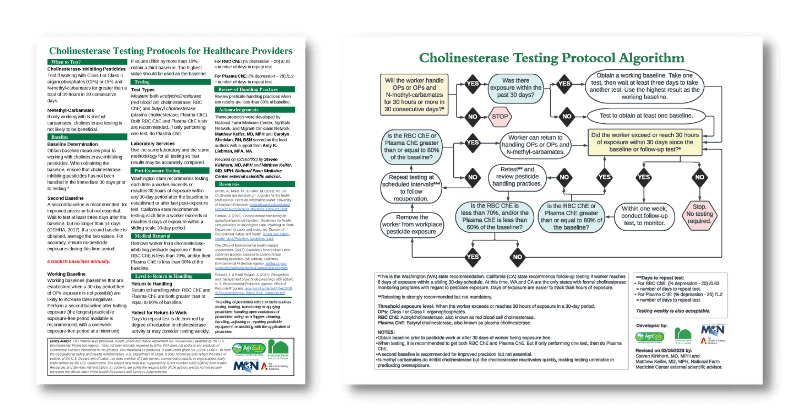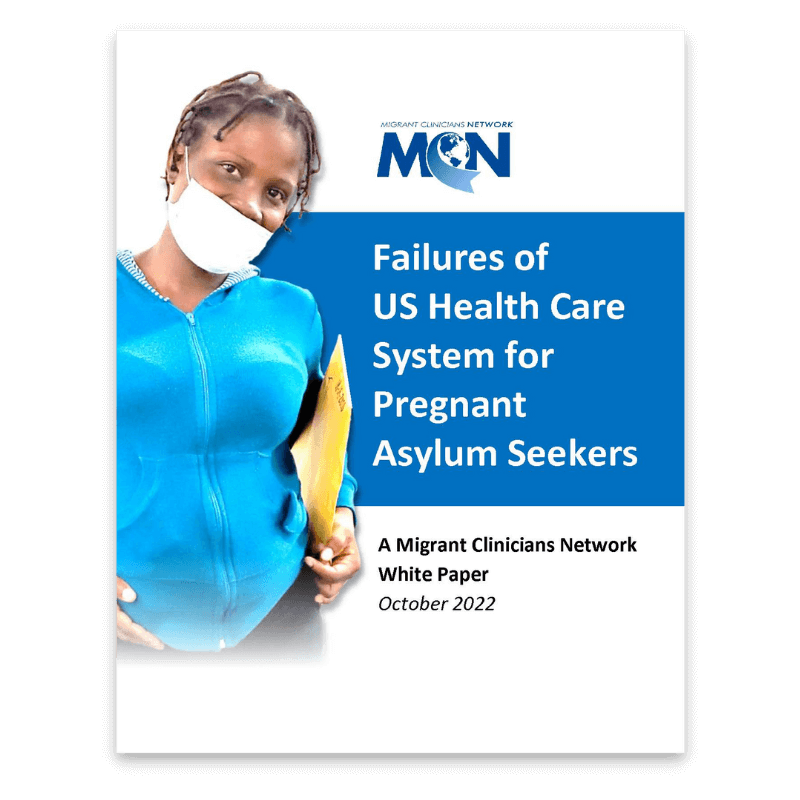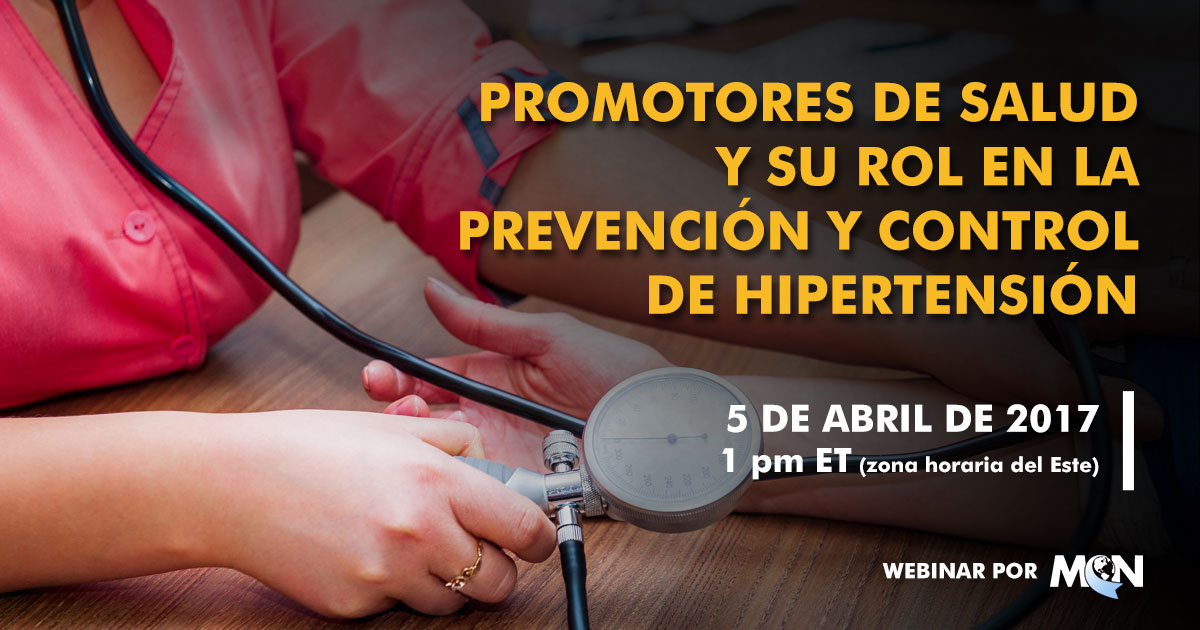
These Cholinesterase (ChE) clinical tools provide a concise and simple format to guide clinicians in monitoring the ChE levels for patients working with Class I and Class II organophosphates (OP) or OP and N-methyl-carbamates.

These Cholinesterase (ChE) clinical tools provide a concise and simple format to guide clinicians in monitoring the ChE levels for patients working with Class I and Class II organophosphates (OP) or OP and N-methyl-carbamates.

Migrant Clinicians Network's white paper, “Failures of US Health Care System for Pregnant Asylum Seekers,” outlines how pregnant asylum seekers who have been released into the US to await their asylum hearing face extreme obstacles to secure prenatal care, despite their legal presence within the country.
Without prenatal care, infants will not have the benefit of early screening and treatment for potentially life-threatening diseases and screening for congenital abnormalities, while in utero. Additionally, pregnancies without prenatal care may result in excess utilization of emergency services which produces unforeseen strain on the health care system.
Knowledge of prenatal care needs, cost, lack of insurance, transportation, refusal by health centers, and fear are delineated as key barriers for pregnant asylum seekers from accessing the care they need during their pregnancy.
Press contact: Claire Hutkins Seda, cseda@migrantclinician.org.

Migrant Clinicians Network's white paper, “Failures of US Health Care System for Pregnant Asylum Seekers,” outlines how pregnant asylum seekers who have been released into the US to await their asylum hearing face extreme obstacles to secure prenatal care, despite their legal presence within the country.
Without prenatal care, infants will not have the benefit of early screening and treatment for potentially life-threatening diseases and screening for congenital abnormalities, while in utero. Additionally, pregnancies without prenatal care may result in excess utilization of emergency services which produces unforeseen strain on the health care system.
Knowledge of prenatal care needs, cost, lack of insurance, transportation, refusal by health centers, and fear are delineated as key barriers for pregnant asylum seekers from accessing the care they need during their pregnancy.
Press contact: Claire Hutkins Seda, cseda@migrantclinician.org.
"The Global Report on Internal Displacement presents the latest information on internal displacement worldwide caused by conflict, violence and disasters."

FECHA DE GRABACION: 5 de Abril de 2017, 1 pm ET (zona horaria del Este)
ORADORA: Ileana Ponce-González, MD, MPH, CNC
Para recibir credito de Trabajador/a de Salud Comunitaria o Educacion de Continua de Enfermera después de ver alguno de estos seminarios usted debe hacer lo siguiente:
En este webinar, los participantes podrán identificar las medidas de desempeño de la Administración de Servicios de Recursos de Salud relacionadas con la hipertensión, describir cómo medir la hipertensión en el cuerpo, entender cómo alentar a los pacientes a controlar y manejar su presión arterial alta y entender las principales barreras que enfrentan pacientes en el control y manejo de su presión arterial alta.
Este proyecto cuenta con el apoyo de la Administración de Recursos y Servicios de Salud (HRSA) del Departamento de Salud y Servicios Humanos de los Estados Unidos bajo el acuerdo de cooperación número U30CS09742, Asistencia Técnica a Centros de Salud Comunitarios y Migrantes y Personas sin Hogar por $ 1,094,709.00 con 0% del total Proyecto NCA financiado con fuentes no federales. Esta información o contenido y las conclusiones son las del autor y no deben ser interpretadas como la posición o política oficial de, ni cualquier endosos deben ser inferidos por HRSA, HHS o el Gobierno de los Estados Unidos.
Includes EPA manual "How to Comply With the 2015 Revised Worker Protection Standard For Agricultural Pesticides - What Owners and Employers Need To Know" and an excerpt specifically for clininicians regarding medical evaluation and respirator fit test. See also the medical evaluation questions in English and Spanish.
This 90-minute webinar was created for physicians, nurses, and other health professionals who treat and case manage patients with active TB. The webinar introduced the 2016 Official American Thoracic Society/Centers for Disease Control and Prevention/Infectious Diseases Society of America Clinical Practice Guidelines: Treatment of Drug-Susceptible Tuberculosis. This training highlighted the guidelines development process, the key changes in recommendations, and discussed the evidence supporting the changes. The webinar was originally presented on November 4, 2016. This training was jointly sponsored by all 5 RTMCCs.
The 1999–2013 United States Cancer Statistics (USCS): Incidence and Mortality Web-based Report includes the official federal statistics on cancer incidence from registries that have high-quality data, and cancer mortality statistics. It is produced by the Centers for Disease Control and Prevention (CDC) and the National Cancer Institute (NCI). This report shows that in 2013, 1,536,119 Americans received a new diagnosis of invasive cancer, and 584,872 Americans died of this disease (these counts do not include in situ cancers or the more than 1 million cases of basal and squamous cell skin cancers diagnosed each year).
This year’s report features information on invasive cancer cases diagnosed during 2013, the most recent year of incidence data available, among residents of 49 states, six metropolitan areas, and the District of Columbia—geographic areas in which about 99% of the U.S. population resides. Incidence data are from CDC’s National Program of Cancer Registries (NPCR) and NCI’s Surveillance, Epidemiology, and End Results (SEER) Program. Data from population-based central cancer registries in these states and metropolitan areas meet the criteria for inclusion in this report.
The report also provides cancer mortality data collected and processed by CDC’s National Center for Health Statistics. Mortality statistics, based on records of deaths that occurred during 2013, are available for all 50 states and the District of Columbia.
The report also includes incidence rates and counts for Puerto Rico for 2009 through 2013 by sex and age, as well brain tumor and childhood cancer data.
USCS data are presented in the following applications—
The 1999–2013 United States Cancer Statistics (USCS): Incidence and Mortality Web-based Report includes the official federal statistics on cancer incidence from registries that have high-quality data, and cancer mortality statistics. It is produced by the Centers for Disease Control and Prevention (CDC) and the National Cancer Institute (NCI). This report shows that in 2013, 1,536,119 Americans received a new diagnosis of invasive cancer, and 584,872 Americans died of this disease (these counts do not include in situ cancers or the more than 1 million cases of basal and squamous cell skin cancers diagnosed each year).
This year’s report features information on invasive cancer cases diagnosed during 2013, the most recent year of incidence data available, among residents of 49 states, six metropolitan areas, and the District of Columbia—geographic areas in which about 99% of the U.S. population resides. Incidence data are from CDC’s National Program of Cancer Registries (NPCR) and NCI’s Surveillance, Epidemiology, and End Results (SEER) Program. Data from population-based central cancer registries in these states and metropolitan areas meet the criteria for inclusion in this report.
The report also provides cancer mortality data collected and processed by CDC’s National Center for Health Statistics. Mortality statistics, based on records of deaths that occurred during 2013, are available for all 50 states and the District of Columbia.
The report also includes incidence rates and counts for Puerto Rico for 2009 through 2013 by sex and age, as well brain tumor and childhood cancer data.
USCS data are presented in the following applications—
The U.S. Environmental Protection Agency’s (EPA) Worker Protection Standard (WPS) provides basic workplace protections to farmworkers and pesticide handlers to minimize the adverse effects of pesticide exposure. EPA announced major revisions to the WPS in September 2015. MCN and FJ's fact sheet provides a summary of the revised regulation.
The National LGBT Health Education Center provides educational programs, resources, and consultation to health care organizations with the goal of optimizing quality, cost-effective health care for lesbian, gay, bisexual, and transgender (LGBT) people.
http://www.asbestosdiseaseawareness.org/
ADAO is the largest independent nonprofit in the U.S. dedicated to preventing asbestos exposure, eliminating asbestos-related diseases, and protecting asbestos victims' civil rights through education, advocacy, and community initiatives.
The Inter-professional Oral Health Faculty Toolkit, developed by the Oral Health Nursing Education and Practice program, is now available.The toolkit is an innovative web-based open source product intended to facilitate integration of oral-systemic health content and clinical competencies into nurse practitioner and midwifery curricula.
"Abstract: Unathorized (undocumented) immigrants are less likely than other residents of the United States to have health insurance. The American College of Obstetricians and Gynecologists has long supported a basic health care package for all women living within the United States without regard to their country of origin or documentation. Providing access to qualify health care for unauthorized immigrants and their children, who often were born in the United States and have U.S. citizenship, is essential to improving the nation's publc health."
Recently in the UK, there has been research supporting midwifery care. Due to this research, the UK has made some policy changes in regards to maternity. Midwifery care has been shown to be more safe for women with uncomplicated pregnancies and because of these new policies, the United States may follow in their footsteps.
The National Nework for Oral Health Access has developed a user’s guide that provides a structure, options, and suggestions to help Health Centers develop programs to implement oral health competencies that integrate oral health care into primary care practice, which increases access to oral health care and improves the oral health status of the populations Health Centers serve.
For the first time, the U.S. Preventive Services Task Force has released an e-book version of its Guide to Clinical Preventive Services. The e-book is compatible with many readers, including Kindle, Nook, iBook, and Kobo. The new “Guide to Clinical Preventive Services, 2014” is a comprehensive resource that can help primary care clinicians and patients decide together which preventive services are right for a patient’s needs. It includes all active Task Force evidence-based recommendations since 2004, including 28 new and updated recommendations since the 2012 guide, in a format meant for use at the point of patient care. It also includes information about topics in development, clinical summary tables and additional resources.
This report captures important happenings in occupational health and safety from August 2013 through July 2014. Authoured by researchers from the George Washington University Milken Institute School Of Public Health, this resource focuses on workplace injury and illness statistics each spring and documents successes, challenges, and areas ripe for improvement in occupational health and safety.
Part 5 of the 6 webinar series: Essential Clinical Issues in Migration Health
DATE RECORDED: June 5, 2014
PRESENTED BY: Katherine Brieger, RD and Elizabeth Magenheimer
To receive CME* or CNE credit after viewing any of these webinars you must do the following:
|
Diabetes continues to be one of the most common and challenging health condition confronting migrants and other underserved populations. It is clear that a healthy lifestyle is critical to mitigating the impact of diabetes on individuals and the population, however effective and appropriate interventions can be difficult to design. Fairhaven Community Health Center in Connecticut and Hudson River Healthcare in New York, are two health centers that have long led the way in creating culturally appropriate lifestyle programs for migrants and other underserved patients. In this session the presenters will discuss lessons learned from the development of a variety of programs for diabetics and other patients including a community garden, nutrition classes, cooking classes, weight management and strategies to encourage exercise. The session will address the clinical core measures related to nutrition and BMI and will also discuss current research test second line drug effectiveness in Type 2 DM. Available in English
Learning Objectives:
FURTHER READING |
Download the Spanish Toolkit Materials
National Diabetes Information Clearinghouse, http://diabetes.niddk.nih.gov/dm/pubs/preventionprogram Bright Bodies, http://brightbodies.org |
Limited data document the multiple and repeated pesticide absorption experienced by farmworkers in an agricultural season or their risk factors.
Laboratory studies and case reports of accidental exposure to large amounts of chemicals indicate that there are immediate and long‐term negative health consequences of exposure to agricultural chemicals.
The goal of this study was to describe acute occupational pesticide-related illnesses among youths and to provide prevention recommendations. Survey data from 8 states and from poison control center data were analyzed.
Concern about the adverse public health and environmental effects of pesticide use is persistent. Recognizing the importance of surveillance for acute occupational pesticide-related illness, we report on surveillance for this condition across multiple states. Between 1998 and 1999, a total of 1,009 individuals with acute occupational pesticide-related illness were identified by states participating in the SENSOR-pesticides program.
In response to limitations in state-based occupational disease surveillance, the California Department of Health Services developed a model for surveillance of acute, work-related pesticide illness. The objectives were to enhance case reporting and link case reports to preventive interventions. Risk factors for pesticide illness were prevalent.
The California Pesticide Illness Surveillance Program (PISP) is a major resource for pesticide illness epidemiology. This work attempts to improve characterization of pesticide illness in California, evaluate case ascertainment of the PISP and identify PISP’s limitations and biases for studying the incidence and epidemiology of pesticide-related illness.
Public health surveillance for acute pesticide intoxications is discussed. Explanation of the goals, components and functions of population-based surveillance is provided with reference to key informational sources.
Pesticide Action Network, United Farmworkers of America, and California Rural Legal Assistance Foundation analyzed California government data on agricultural poisonings and enforcement of worker safety standards. Nearly 500 pesticide poisonings were reported for California farmworkers every year. The actual number of pesticide-related illnesses is unknown, since many poisonings go unreported.
Surveillance data show that pesticide-related illness is an important cause of acute morbidity among migrant farm workers in California. Exposures occur in various ways (e.g., residues, drift), suggesting that the use of pesticides creates a hazardous work environment for all farm workers Improved education for health care providers should be a priority. Growers should be educated about alternative forms of pest control and incentives should be provided to encourage their use.
Describes the growth from 1987 through 1996 of the Occupational Pesticide Poisoning Surveillance Program at the Texas Department of Health. The program was initially based on a Sentinel Event Notification System for Occupational Risks (SENSOR) model, using sentinel providers to report cases, supplementing the passive reporting by physicians that was required by law.
The authors describe the growth of the Occupational Pesticide Poisoning Surveillance Program at the Texas Department of Health. The program was based on a Sentinel Event Notification System for Occupational Risks(SENSOR) model, using sentinel providers to report cases. The number of confirmed occupational cases increased from 9 workers in 1987 to 99 workers in 1996.